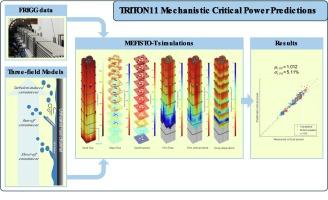Mechanistic prediction of Westinghouse TRITON11®# BWR fuel critical power with MEFISTO-T subchannel analysis code
IF 1.9
3区 工程技术
Q1 NUCLEAR SCIENCE & TECHNOLOGY
引用次数: 0
Abstract
The TRITON11® fuel design is the latest Boiling Water Reactor (BWR) fuel product developed by Westinghouse, based on an 11 × 11 optimized fuel rod lattice, including mixing vane spacer grids, three large water rods and 18 part-length rods. The design offers larger fuel cycle cost saving, improved fuel reliability and increased thermal margin over previous Westinghouse fuel products. The critical power performances of the TRITON11 fuel design were assessed at the Westinghouse thermal–hydraulic FRIGG loop using a full-scale test bundle covering a wide range of BWR core conditions (covering normal operation and Anticipated Operational Occurrences) with various radial and two axial power distributions. The resulting FRIGG steady state database was simulated with Westinghouse subchannel analysis code MEFISTO-T based on a two-phase three-field approach of annular two-phase flow, accounting for the drop deposition enhancement provided by the spacer grids. A new model of local film entrainment was introduced due to the liquid “scrapping off” effects provided by the frame and side vanes of the spacer grids along the fuel channel and water rods. After spacer grid effect calibration, the steady state critical power is simulated mechanistically by power iterations up to complete local film dryout. The MEFISTO-T code can successfully predict the critical power performance of the Westinghouse TRITON11 BWR fuel design, including on part-length rods, with almost no bias and trend, within a standard deviation of about 5 %.

利用 MEFISTO-T 子信道分析代码对西屋 TRITON11®# 核燃料堆燃料临界功率进行机理预测
TRITON11® 燃料设计是西屋公司开发的最新沸水堆(BWR)燃料产品,以 11 × 11 优化燃料棒晶格为基础,包括混合叶片间隔网格、三根大型水棒和 18 根部分长度的燃料棒。与西屋公司以前的燃料产品相比,该设计可节省更多的燃料循环成本、提高燃料可靠性并增加热裕度。TRITON11 燃料设计的临界功率性能是在西屋公司热-液压 FRIGG 循环系统中使用全尺寸测试束进行评估的,该测试束涵盖了各种核燃料循环反应堆堆芯条件(包括正常运行和预期运行事故)以及各种径向和两个轴向功率分布。西屋公司的子通道分析代码 MEFISTO-T 基于环形两相流的两相三场方法,对由此产生的 FRIGG 稳态数据库进行了模拟,并考虑到了间隔网格提供的液滴沉积增强效果。由于沿燃料通道和水棒的间隔格栅的框架和侧叶片提供了液体 "刮除 "效应,因此引入了新的局部薄膜夹带模型。在对间隔栅效应进行校准后,通过功率迭代对稳态临界功率进行机械模拟,直至局部薄膜完全干涸。MEFISTO-T 代码可以成功预测西屋 TRITON11 双燃料反应堆燃料设计的临界功率性能,包括部分长度的燃料棒,几乎没有偏差和趋势,标准偏差在 5% 左右。
本文章由计算机程序翻译,如有差异,请以英文原文为准。
求助全文
约1分钟内获得全文
求助全文
来源期刊

Nuclear Engineering and Design
工程技术-核科学技术
CiteScore
3.40
自引率
11.80%
发文量
377
审稿时长
5 months
期刊介绍:
Nuclear Engineering and Design covers the wide range of disciplines involved in the engineering, design, safety and construction of nuclear fission reactors. The Editors welcome papers both on applied and innovative aspects and developments in nuclear science and technology.
Fundamentals of Reactor Design include:
• Thermal-Hydraulics and Core Physics
• Safety Analysis, Risk Assessment (PSA)
• Structural and Mechanical Engineering
• Materials Science
• Fuel Behavior and Design
• Structural Plant Design
• Engineering of Reactor Components
• Experiments
Aspects beyond fundamentals of Reactor Design covered:
• Accident Mitigation Measures
• Reactor Control Systems
• Licensing Issues
• Safeguard Engineering
• Economy of Plants
• Reprocessing / Waste Disposal
• Applications of Nuclear Energy
• Maintenance
• Decommissioning
Papers on new reactor ideas and developments (Generation IV reactors) such as inherently safe modular HTRs, High Performance LWRs/HWRs and LMFBs/GFR will be considered; Actinide Burners, Accelerator Driven Systems, Energy Amplifiers and other special designs of power and research reactors and their applications are also encouraged.
 求助内容:
求助内容: 应助结果提醒方式:
应助结果提醒方式:


